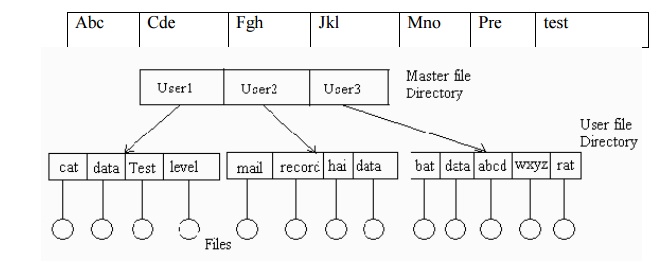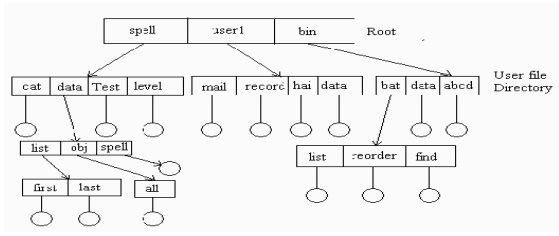Chapter: Operating Systems : File Systems
Directory Structure
DIRECTORY STRUCTURE
There are five directory structures. They are
Single-level directory
Two-level directory
Tree-Structured directory
Acyclic Graph directory
General Graph directory
1. Single
– Level Directory
The simplest directory structure is the single-
level directory.
All files are contained in the same directory.
Disadvantage:
When the number of files increases or when the
system has more than one user, since all files are in the same directory, they
must have unique names.
Directory

2. Two – Level Directory
In the two level directory structures, each user
has her own user file directory (UFD).
When a user job starts or a user logs in, the
system’s master file directory (MFD) is searched. The MFD is indexed by user
name or account number, and each entry points to the UFD for that user.
When a user refers to a particular file, only his
own UFD is searched.
Thus, different users may have files with the same
name.
Although the two – level directory structure
solves the name-collision problem
Disadvantage:
v Users
cannot create their own sub-directories.
3. Tree
– Structured Directory
v A tree is
the most common directory structure.
v The tree
has a root directory. Every file in the system has a unique path name.
v A path
name is the path from the root, through all the subdirectories to a specified
file.
v A
directory (or sub directory) contains a set of files or sub directories.
v A
directory is simply another file. But it is treated in a special way.
v All
directories have the same internal format.
v One
bit in each directory entry defines the
entry as a file (0) or as a subdirectory
(1).
v Special
system calls are used to create and delete directories.
v Path
names can be of two types: absolute path names or relative path names.
v An
absolute path name begins at the root and follows a path down to the specified
file, giving the directory names on the path.
v A
relative path name defines a path from the current directory.
4. Acyclic
Graph Directory.
An acyclic graph is a graph with no cycles.
To implement shared files and subdirectories this directory
structure is used.
An acyclic – graph directory structure
is more flexible than is a simple tree structure, but it is also more complex.
In a system where sharing is implemented by symbolic link, this situation is
somewhat easier to handle. The deletion of a link does not need to affect the
original file; only the link is removed.
Another approach to deletion is to preserve the file until all
references to it are deleted.
To implement
this approach, we
must have some mechanism for
determining that
the
last reference to the file has been
deleted.


Related Topics